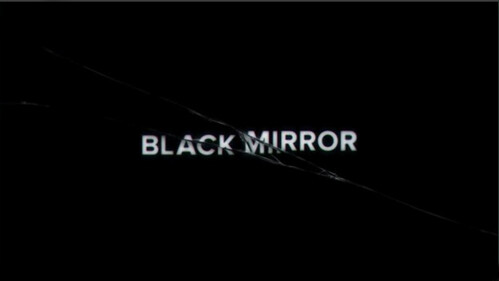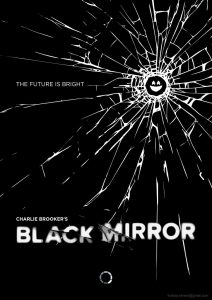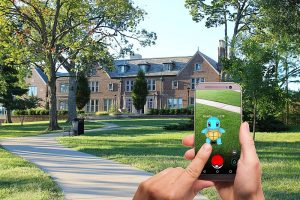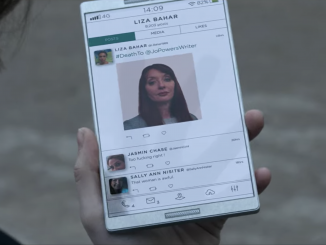
From the first serialized season to the fifth, Black Mirror series has been released for ten years, which tells a lot about the internet and technology affect people’s social life, privacy, trust, snooping, and so on. We can get a glimpse of how the Internet technology in different stages of development affects human sensory experience and judgment, and find the worries that as the Internet and other electronic media continue to develop, the boundary of reality and virtuality is becoming more and more blurring.
Screen as black mirror
Everyone has a “black mirror,” a screen, a monitor, a smartphone in every home, on every table, and in the palm of every hand, all of which are black mirrors reflecting current reality, which is the inspiration for the TV series Black Mirror (Riener et al., 2019). The screen is a medium that connects the online world with the real world, and through it, people are transformed from real relationships to online in a way that traditional media cannot. Although representational media has long tried to escape the perceptual reach of the screen, contemporary digital technology has shown a qualitative leap in this regard (Jones, 2020). This is also reflected in Black Mirror, where all the technical settings are almost always carried by visual media, including electronic screens, augmented reality devices, Vr devices, etc.

Virtual vs. reality
The development of technology is blurring the virtual and the real, interfering with people’s ability to read. Augmented reality, as a representative emerging technology on the Internet, is a technology that facilitates the integration between real-world information and virtual-world information content. Although it has a history of more than half a century, augmented reality technology has developed rapidly in the past few years, gradually coming into the view of mass consumers (Pesce, 2021)
The third season of Black Mirror also introduces more augmented reality and Virtual Reality things, and other elements to keep up with the times. In the story “Playtest”, the protagonist Cooper participates in testing a game’s “interactive augmented reality system”. Before entering the game, he was very confident about what he would face, because he had a way to distinguish between virtual and reality.
Before the test started, the staff told him that no matter how real it was in front of him, it was only in the visual and auditory dimensions, and the virtual stuff would not give you other sensations like touch. Also, there is staff through the headset in his ear voice pointers, these are the markers that allow him to easily distinguish between the two worlds in his own consciousness. However, as the game continued, the headset failed, and then he had a sense of touch and was thrown into panic. Because of the loss of the two judgment criteria, as a person, all the senses that the hero uses to contact the real world have been opened by the virtual, which means that he has lost the way to distinguish between the virtual and the real.
When people can “see” technological entities, they can understand and control them. However, as they disappear from view, but at the same time have enormous new capabilities to shape our perception of reality, one has to consider their security and how to control them (Pesce, 2020).
So what really scares people is not the realism of the virtual images, but the fact that as humans we need to have the power to control the virtual, to stop it when we want to, and this is expressed in the play by the word “STOP” in the mouth of the protagonist. Augmented reality, as a technology that amplifies the inherent cognitive and perceptual abilities of humans, has been developed as a control technology (Pesce, 2017).

In the same year that the third season of Black Mirror was released, augmented reality also came into the public eye in the form of a game: Pokemon Go. Pokemon Go was released and took the world by storm, allowing people who usually stay at home to come out and “catch the genie”. It refreshed the record of the fastest game to top the iOS and Google Play best-seller list in the United States, making countless people fascinated by it. In addition to its own highly innovative gameplay, it is worth one that the game has filled the gap in the field of augmented reality.
However, Pokemon Go has also raised some controversial social issues when it was a big hit, and Pokemon players have been labeled as “dangerous game players”. For example, “a teenager in Guatemala was shot dead after playing Pokemon Go and breaking into a private home”, “criminals used Pokemon Go to commit robberies”, “a driver playing Pokemon Go caused a car accident”. It is for this reason that there are also people who are against this game. Explaining it theoretically, changes in the environment cause humans to sense and react, yet when computer technology combines the game with real space, it amplifies its effects on people (Pesce, 2020). When technology is overly involved in people’s brains and humans are unable to restrain their involvement, inaccurate judgments of reality are bound to occur.
The maybe future
The power of Internet development is in the hands of technology giants. Mark Zuckerberg said at facebook’s annual conference that augmented technology will be the core technology of facebook’s future, while several other major tech corporations such as Apple, Google, Amazon, and Microsoft has also developed augmented reality technology to compete for the market. At the same time, augmented reality is also attracting the participation of the country because of the possibility of using it to manage the behavior of citizens (Pesce, 2020).
Regulation plays a crucial role in development. Even if corporations or counties can avoid this temptation, the fundamental nature of augmented reality means that there is a high degree of spatial surveillance. Because of the way it operates, as an augmented reality system, it is also a highly complex surveillance system. In order to keep the information up to date, the system must constantly scan the world, and human activity will come to their attention and be compiled into a stream of valuable data (Pesce, 2020). People’s privacy becomes an issue, and this surveillance acts like an invisible hand, collecting information and then predicting and further manipulating people’s behavior. In such a situation, it becomes difficult to tell whether it is the true heart or the prescribed direction and whether people will be kidnapped by technology to follow the established direction. People are living in a digital era, in a room created by a huge screen, with mechanical life and completely kidnapped aesthetics and values.
Conclusion
Black Mirror tends to be pessimistic about technology (Allal-Chérif, 2021), and it’s true that such negative scenarios tend to be more appealing and nerve-wracking to viewers. Yet the reality is that the Internet and electronic media have never slowed down in their development, as they have only been around for a few decades, they have already permeated people’s lives. As Lee (2018) said at Web Summit companies must do more to ensure that their pursuit of short-term profits does not come at the expense of human rights, democracy, scientific facts, or public safety as they develop Internet technologies. In the quest for betterment, governments, companies, and individuals should all be paying attention at their own level.
References
Allal-Chérif, O. (2021). ‘Black Mirror’: the dark side of technology. The Conversation. Retrieved from https://theconversation.com/black-mirror-the-dark-side-of-technology-118298.
Jones, N. (2020). 4. Immersion: Entering the Screen. In Spaces Mapped and Monstrous: Digital 3D Cinema and Visual Culture (pp. 92-114). New York Chichester, West Sussex: Columbia University Press. https://doi-org.ezproxy.library.sydney.edu.au/10.7312/jone19422-008
Pesce, M. (2017). The Last Days of Reality. Meanjin. Retrieved from https://meanjin.com.au/essays/the-last-days-of-reality/.
Pesce, M. (2021). Augmented reality: Unboxing tech’s next big thing. Polity.
Riener, A., Gabbard, J., & Trivedi, M. (2019). Special Issue of Presence: Virtual and Augmented Reality Virtual and Augmented Reality for Autonomous Driving and Intelligent Vehicles: Guest Editors’ Introduction. PRESENCE: Virtual And Augmented Reality, 27(1), i-iv. https://doi.org/10.1162/pres_e_00323
30 years on, what’s next #ForTheWeb?. World Wide Web Foundation. (2021). Retrieved from https://webfoundation.org/2019/03/web-birthday-30/.

This work is licensed under a Creative Commons Attribution 4.0 International License.

